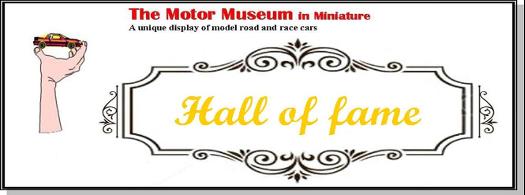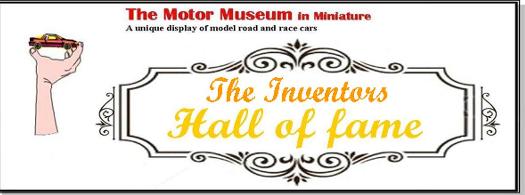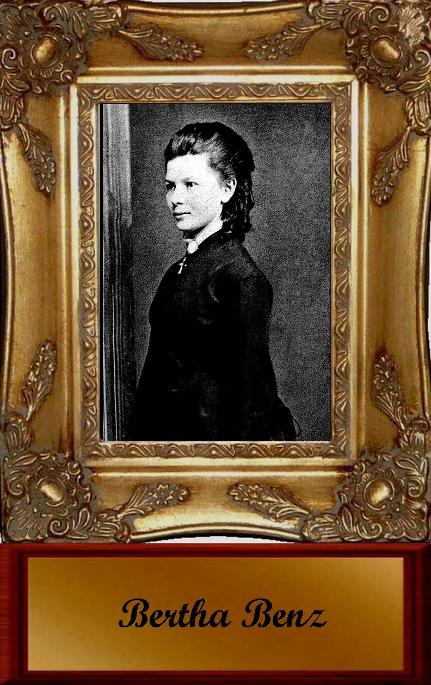
MMIM Hall of Fame
Bertha Benz
Born on the 3rd of May 1849 Cäcilie Bertha Ringer was to become arguably the most influential woman in automotive history.
Amongst the names of pioneering female motorists, racing drivers Mdm. Du Gast, Dorothy Levit and Kay Petre; driven business women like Louise Sarazin or benefactresses like the Honorouble Dorothy Paget; or even Violet Cordery who drove right around the world with her sister Evelyn, how does Bertha Benz rank so highly?
Simple; if it hadn't been for Bertha there’s a real possibility that the others might not have even had a chance to achieve their place in motoring history. Little wonder the motoring journalist and author Andrew Frankel calls her “the mother of motoring”.
Bertha Ringer was the daughter of a wealthy family from Pforzheim, a town in the southwest of Germany close to the Black Forest. The Town was once nickname "Goldstadt" or Golden City because of it’s high status jewellery and watch-making industries, a fact also recognised by the first workers' union in Pforzheim being the "Pforzheim Gold Craftsmen's Union” established in 1869. Bertha would be “a lady of independent means”.
More than a wife to Karl Benz; she was his business partner, and certainly not a silent one. The life stories of Bertha and Karl Benz are difficult to separate as the old adage that “behind every great man is a great woman” couldn’t be more true in this instance.
Karl Benz had founded a company in Mannheim with a mechanic, August Ritter. The "Iron-foundry and workshop" had its tools confiscated by the bailiffs in 1871 and the unreliable Ritter proved to be less than outstanding business partner. Finding him in somewhat difficult situation it was Bertha Ringer, then Benz’ fiancée, that helped Benz overcome this obstacle. Without hesitation she used her dowry to buy Ritter out of the business. Bertha would not have been able to do this were it not still before their marriage; by law married women lost the legal power to act independently.
The technically-minded Karl Benz may have been a supremely talented engineer, but he was a terrible marketer. Using Bertha’s continued financial support (and business acumen) to form a new manufacturing venture, known as Benz & Cie, Karl was able to establish a successful company, successful enough to allow him to turn his attention to a lifelong dream; the creation of the first true auto-mobile.
On July 20, 1872 Bertha Ringer married Karl Benz. Together they had two sons and three daughters: Eugen (1873), Richard (1874), Clara (1877), Thilde (1882) and Ellen (1890). While we might suppose that Bertha would settle down to run the family, as Karl tinkered in the garage, it probably wasn't that way at all. Benz was known to work on the kitchen table and Bertha would later demonstrate exceptional knowledge of the auto-mobiles design and practicalities, so it seems clear she was more heavily involved than one assumes.
After several years of failed attempts Karl was able to produce a working “horseless carriage” in December 1885 and in January 1886 Reich Patent No. 37435 was issued to Dr. Karl Benz. A document now recognised as the ‘Birth Certificate’ of the motor car.
The machine was a three wheeled car, one steerable wheel in front and two driven wheels at the back. It drew heavily on the bicycle technology of the time and was all constructed and designed for the purpose of moving itself and it’s passengers, unlike Daimler's first motor car which was a converted carriage pressed into service as an engine mount.
Karl’s car had a 1.6-litre single-cylinder engine giving 2.5hp and featured Benz own electric battery spark ignition system. The engine ran on the petroleum distillate, Ligroin; now better known as a solvent. To our eyes it would be very rudimentary, engine cooling was achieved by pouring water onto it, letting the heat evaporate away; the simple lubrication system was by means of a drip feed that was in no way enclosed, meaning oil which was not burned off at one end of the cylinder simply fell out of the other end of what was an open crankcase onto the ground. Nevertheless the car could reach a top speed of 25 mph; staggering for the era.
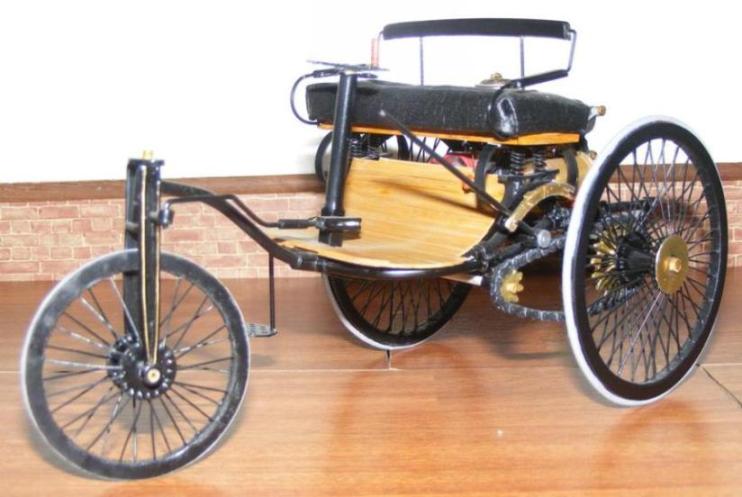
Another thing obvious to the outsider is Karl’s lack of ambition for his invention. To Karl it was a scientific-cum-engineering problem and once each item was solved he simply moved onto the next problem in the chain. His vision was so limited it didn't occur to him fit a decent size fuel tank, why would he, it only needed to go for short runs to prove whether something worked or not!
The first public outings for this new invention didn't go too well, one demonstration run even came to a crashing halt when the driver lost control of the vehicle and smashed into a wall; one can only guess at the looks on the faces of the terrified onlookers. Benz was a perfectionist and being prone to bouts of depression, born out of self-doubt, returned to his workshop and tinkered with his machine in private, wholly refusing to promote an invention that wasn't completely perfect.
Bertha, on the other hand believed that they needed to publicize their auto-mobile as much as possible, especially as another German engineer, Gottlieb Daimler, had also successfully run a four-wheeled horseless carriage of his own! Bertha not only kept the family afloat in these lean years but also encouraged her parents to use her inheritance to fund the company too. While Karl's research and hard work led to him building three prototypes he remained steadfastly opposed to advertising his auto-mobiles until they were ‘absolutely perfect’.
Bertha repeatedly and resolutely defended her husband’s work when most people were deeply sceptical of this new means of transportation, but she couldn't convince Karl of the need for publicity. So, totally convinced the people needed to see the vehicles doing proper journeys, Bertha decided to take matters into her own hands. Happily for us Bertha was more than a visionary businesswoman, she was a determined lady with a practical mind and a stubborn streak clearly as strong as her husband’s! She came up with a cunning plan.
Early in August 1888 (possibly the 5th or 12th of August depending in which sources you believe), Bertha went to visit her mother, nothing unusual about that you say, well, no; but she went by car! Clearly in league with her boys a trio of Benzes crept from the house in Mannheim and pushed the newly constructed ‘Patent Motorwagen No. 3’ down the road from the house so as not to alert Karl to the theft of his vehicle. Had he been consulted Karl would never have allowed such a journey, fraught with risk and clearly giving opportunity for failure and public humiliation.
Bertha saw the potential of the journey rather differently. While the stated purpose of the trip was a visit to her mother it is clear she intended to demonstrated that the car had a practical use and thereby boost interest, confidence and investment in the work of her brilliant husband. Let’s take a minute to consider what this undertaking involved. Firstly a woman driving a machine and travelling independently wasn't the ‘done thing’. There were no fuel stations, garages or breakdown services, Karl’s trips had all been short trials and always accompanied by mechanical assistants. There were no established routes with road signs and in places the roads were rocky, dusty and unpaved tracks, not ‘roads’ at all. Such a journey in our terms would be like setting off to visit the moon in an unproven shuttle craft built from home made rocket parts in the back garden shed!
Not only did Bertha fail to involve Karl in her plans, she didn't tell any of the local authorities either. It is fair to say that there may not have been an appropriate authority to ask permission of and we can guess what most councils might have said had permission been sought! Bertha, probably following the modern idiom that “it is better to seek forgiveness than to ask permission”, simply left Karl a note, and went. The 39 year old mother and her sons Eugen 15 and Richard 14, started the trip to Pforzheim, around 56 miles away, and in so doing set course into the history books; most likely saving Karl from professional and financial ruin too.
With Bertha acting as both driver, and mechanic, the trio ‘phut-phutted’ onwards in what was essentially the wrong direction. Instead of setting off south towards Brühl they went east to Schreisheim! Was this a part of Bertha’s cunning plan to visit a few extra towns for publicity reasons, or simply a lack of road signs leading to a slight detour? We might never really know but we do know she took a very different route home again three days later, but with some equally indirect roads featuring once again. The most obvious reason is that this just had to be a route that went from town to town in order to ensure a regular supply of cooling water and engine fuel, but it certainly had the benefit of attracting attention from a wider area.
The red route is that taken from Mannheim outward bound to Pforzheim, the blue follows the route taken three days later back to Mannheim. Only Bruchnal has the honour of being visited twice!
Perhaps now is the time to here from Bertha herself. I'm sorry the translation isn't perfect but it gives a certain feel of what the journey into the unknown may have been like for the three travellers as they sort to fathom out their journey.
Bertha recorded:-
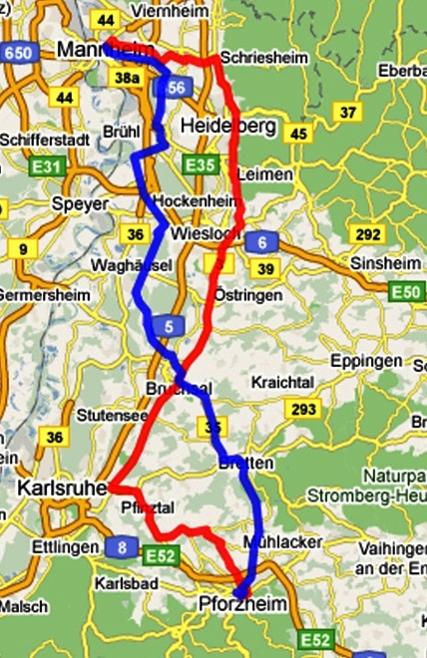
“I’m from Pforzheim and my mother was an avid follower of our car. When our sons Richard and Eugen arrived in the summer 1888, they wanted to make a trip in the car, I thought that my mother would prepare a great joy when we visit them. But Carl would never have allowed. Early in the morning we left, so we were already far up the dad woke up hours: 15 year old boy and I and a real conspiracy instigated - and so, the two have 13. Ligroin, as it was called at that time the gasoline, we had it as a spare. In Wiesloch we had to refuel something.
The ligroin we bought at the pharmacy.
As there were difficulties because we had no low gear
for the slopes. As Richard and I have to move often. Downhill and I
was afraid, because we had very simple braking. On the way we had done
extensive rest, because I wanted to become as dirty as we were not arriving in
brightness in Pforzheim.
Two bad periods, there has been on the trip: one time was the fuel line clogged - my hairpin helped. The other time the ignition was broken. I have repaired with my garter. So I have shown first that the "daddy" his car is also good for long distances. And on my suggestion he then built a third gear for mountain rides. And today, all the cars in the world - I am very proud of it!
And when we arrived, my mother was away. Since then we have sent a telegram to first time dad that we were in Pforzheim.
Full Pforzheim had stood head and all the relatives wanted to have a ride. Since the Eugen has set up a car service that anyone even think about it came to the three days that we stayed there.
"Spirits" have called our car then the people. The farmer said "Witches carts" to it and threw stones at us or beat us with whips to when we drove across the country. Richard is on the road as often descended to meet us when a horse-drawn vehicle and has stopped and helped pass out the shy animal on the car's engine. And what do we have to pay for startled dogs and chickens.
But in the end we were glad we arrived back safely in Mannheim.”
Bertha actually solved more than the problems she recounts above, clearing the fuel line blockage with a long hat pin and isolating the electrical short circuit weren't even the most difficult issues she tackled. A blacksmith had to help mend a damaged drive chain in Bruchsal. In Bauschlott/Neulingen just north of Pforzheim, Bertha requested that a local cobbler cover the worn wooden break blocks with leather thereby inventing the brake lining and giving us the origin of the term ‘brake shoes’. Clearly Bertha had a great knowledge of the vehicle, mechanics and materials in order to overcome such matters.
The exact journey time isn’t known and there are several speculative suggestions in the area of 12 to 15 hours. The three travellers left Mannheim around dawn, certainly before breakfast, and arrived in Pforzheim somewhat after dusk so the longer time sounds more reasonable. Bertha’s simple telegram to Karl seems somewhat understated in comparison to the enormity of the event.
"journey to Pforzheim succeeded - We arrived at Grandma's."
One is left wondering about the look on Karl’s face as he read the Telegram. I imagine a mixture of amazement and disbelief slowly turning to pride and joy!
After the three days visiting with her mother, and of free rides and fun in Pforzheim, Bertha and the boys returned home, by a different route, once again introducing her husband’s auto-mobile to as far and wide an audience as possible. The first long distance journey by a petroleum powered car had been successfully negotiated and news of the intrepid trio’s endeavour reached the press. Eyewitness reports from amazed, and rather frightened, residents of the towns and villages told of a woman and two young boys travelling on a hissing, thumping, horseless carriage. The sensational story of the bewitched cart spread like wildfire amongst the press, just as Bertha had intended, and the critics of the automobile were silenced. At a time when no other automobile had travelled more than a few dozen feet Bertha had traversed over 120 miles. Suddenly everyone was talking about Benz Patent Motor Car, its reliability and possibilities for the future. Bertha’s publicity stunt was a roaring success.
Her journey is clearly a key event in the technical development of the car but it also gave us a few other ‘firsts’. When Bertha returned home she wrote a written account of the journey, the problems encountered and the solutions she had come up with. Further more she gave Karl a list of suggestions for improvements to the car, not least the urgent addition of a lower range gear so the passengers didn’t have to abondon ship on arrival at a hill. Thus the first recorded road test drive of a petroleom vehicle was made, by a woman, and the first written vehicle test report was made by a womwn too! Oh, and it was the very first incident of the theft of a motor car too.
The Benz Patent-Motorwagen company attracted worldwide attention and began to make their first sales. Inside of ten years Benz & Cie became the world’s largest automobile company, employing more than 400 full-time staff and selling around 600 vehicles a year. In 1906 the family relocated to Ladenburg when a new factory was needed, in time Benz would merge with Daimler and eventually give the world the prestigious and ultra-reliable Mercedes-Benz range.
The Bertha Benz Memorial Route.
To commemorate the trip of 1888 the route was officially approved as a part of “the European Route of Industrial Heritage” and named “The Bertha Benz Memorial Route". In 2008 the German tourist board sign posted the route in Baden-Wurtemberg, from Mannheim, via Heidelberg and Wiesloch, to Pforzheim and back; so that today you can retrace Bertha’s path into history for yourself.
The Bertha Benz Challenge.
In 2011, 125 years after the invention of the auto-mobile, Germany held an official event “Automobile Summer 2011” commemorating Karl Benz. Bertha’s involvement was recognised by holding the first “Bertha Benz Challenge”, on the 10th and 11th of September 2011. The theme was “Sustainable mobility in the former route of the automotive world”, dedicated to a globally visible sign of progress in the search for sustainable mobility. It is now an anual event in which future-oriented vehicles, with hybrid electric alternative systems, hydrogen and fuel cells, follow the memorial route to prove the function of their designs. In subsequent years the cars have left from feature locations to travel to Mannheim making the whole event a three day affair.
Legacy.
Bertha Benz played a decisive part in the development of the auto-mobile. Without her commitment and resolution the auto-mobile would undoubtedly have had a more difficult birth. Karl Benz would have spent the rest of his life obsessively trying to perfect his car so everyone, not just the auto enthusiast owes this awesome lady a huge debt. Take a minute to imagine life without the car, not just our personal transport but the transportation of foodstuffs and goods would be very different.
Perhaps one person had more reason to thank Bertha than anyone. In his memoirs Karl Benz later wrote:
"Only one person remained with me in the small ship of life when it seemed destined to sink. That was my wife."
"Bravely and resolutely she set the new sails of hope.”
